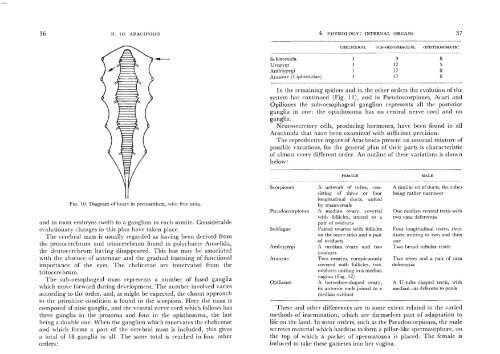You also want an ePaper? Increase the reach of your titles
YUMPU automatically turns print PDFs into web optimized ePapers that Google loves.
36 Il. DE ARACHNIDIS<br />
4. PHYSIOLOGY: INTERNAL ORGANS 37<br />
---<br />
Schizomida<br />
Uropygi<br />
Amblypygi<br />
Araneae (Liphistiidae)<br />
CHELICERAL SUB-OESOPHAGEAL OPISTHOSOMA TIC<br />
9<br />
12<br />
17<br />
17<br />
8<br />
5<br />
0<br />
0<br />
In the remaining spiders and in the other orders the evolution of the<br />
system has continued (Fig. 11), and in Pseudoscorpiones, Acari and<br />
Opiliones the sub-oesophageal ganglion represents all the posterior<br />
ganglia in one: the opisthosoma has no central nerve cord and no<br />
ganglia.<br />
Neurosecretory cells, producing hormones, have been found in all<br />
<strong>Arachnida</strong> that have been examined with sufficient precision.<br />
The reproductive organs of <strong>Arachnida</strong> present an unusual mixture of<br />
possible variations, for the general plan of their parts is characteristic<br />
of almost every different order. An outline of these variations is shown<br />
below:<br />
~'EMALE<br />
MALE<br />
FIG. I 0. Diagram of heart in pericardium, with five ostia.<br />
and in most embryos swells to a ganglion in each somite. Considerable<br />
evolutionary changes in this plan have taken place.<br />
The cerebral mass is usually regarded as having been derived from<br />
the protocerebrum and tritocerebrum found in polychaete Annelida,<br />
the deutocerebrum having disappeared. This loss may be associated<br />
with the absence of antennae and the gradual lessening of functional<br />
importance of the eyes. The chelicerae are innervated from the<br />
tritocerebrum.<br />
The sub-oesophageal mass represents a number of fused ganglia<br />
which move forward during development. The number involved varies<br />
according to the order, and, as might be expected, the closest approach<br />
to the primitive condition is found in the scorpions. Here the mass is<br />
composed of nine ganglia, and the ventral nerve cord which follows has<br />
three ganglia in the prosoma and four in the opisthosoma, the last<br />
being a double one. When the ganglion which innervates the chelicerae<br />
and which forms a part of the cerebral mass is included, this gives<br />
a total of 18 ganglia in all. The same total is reached in four other<br />
orders:<br />
Scorpiones<br />
Pseudoscorpiones<br />
Solifugae<br />
Amblypygi<br />
Araneae<br />
Opiliones<br />
A network of tubes, consisting<br />
of three or four<br />
longitudinal ducts, united<br />
by transversals<br />
A median ovary, covered<br />
with follicles, united to a<br />
pair of oviducts<br />
Paired ovaries with follicles<br />
on the outer sides and a pair<br />
of oviducts<br />
A median ovary and two<br />
oviducts<br />
Two ovaries, conspicuously<br />
covered with follicles, two<br />
oviducts uniting to a median<br />
vagina (Fig. 12)<br />
A horseshoe-shaped ovary,<br />
its anterior ends joined to a<br />
median oviduct<br />
A similar set of ducts, the tubes<br />
being rather narrower<br />
One median ventral testis with<br />
two vasa deferentia<br />
Four longitudinal testes, their<br />
ducts uniting to two and then<br />
one<br />
Two broad tubular testes<br />
Two testes and a pair of vasa<br />
deferentia<br />
A U-tube shaped testis, with<br />
median vas deferens to penis<br />
These and other differences are to some extent related to the varied<br />
methods of insemination, which are themselves part of adaptation to<br />
life on the land. In some orders, such as the Pseudoscorpiones, the male<br />
secretes material which hardens to form a pillar-like spermatophore, on<br />
the top of which a packet of spermatozoa is placed. The female is<br />
induced to take these gametes into her vagina.















